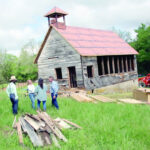Updates given on park projects, plans, staffing
Roaring River State Park held its annual town hall-style meeting on June 29, with about 30 non-park employees in attendance to hear updates on accomplishments, plans, stewardship, law enforcement, the hatchery, staffing and more.
Carl Bonnell, deputy regional director for Missouri State Parks, led the meeting, which began with the introduction of Carrie Byron, the incoming park ranger. Following the retirement of long-time Park Ranger Steve Jabben, hiring new rangers has been a challenge, Bonnell said.
“Carrie is going through the Ranger program and doing ride-alongs, and she will go through the police academy in Joplin,” Bonnell said. “She will do field training and should be on her own in the park in early spring.”
Bonnell said Missouri State Parks is paying for Byron to go through the academy, contractually obligating her to serve a specified amount of time at the park. He said there are only about 50 rangers statewide, and along with the Roaring River position, and Ranger spot at Table Rock Lake State Park remains open.
After Byron’s introduction, Bonnell highlighted the accomplishments and future plans of State Parks staff at Roaring River.
Some of those accomplishments include completing a paving project, fixing water damage at the Emory Melton Inn following a pipe burst on Christmas morning and work on cabins 1 and 2, among others.
Coming down the pike are numerous projects this season, on which Bonnell elaborated.
“The playground has been delayed through the end of July, and we are working with the Cassville Community Foundation to fund that,” he said. “In Campground 2, there’s $200,000$300,000 in work we were going to contract out, but instead we are doing it in-house. This will be elevating as many of the concrete pads as we can and working on the drainage.”
Rotting timbers on the CCC Shelter will also be replaced, Cabin 12 will receive work in the late summer or fall, and a revenue bond for Campground 3 will convert 32 sites to 50-amp service, a delayed project to start in the winter and have a 200-day contract.
“We have $800,000 in American Rescue Plan Act funds to bury a main sewer line under Campground 3 and under the river, and we’ll be working on aging lift stations,” he said. “Infrastructure is costly and is just as important as our facilities.”
Taylor Steinfeldt, Roaring River State Park natural resource ecologist, was next to present, listing a cavalcade of accomplishments and plans in his department.
One of his goals is to build a Riparian habitat in Zone 3, for which he has planted 20 pounds of seed on 2.7 acres.
“We’ll treat it for invasive species, and the native species should take hold in 1-3 years,” he said. “This project will be a success if we have native species to attract pollinators, and it will help during flooding.”
Steinfeldt said he has been managing invasive species of other kinds, like black vultures and European hornets, as well as plants of all kinds.
He mentioned a dye tracing study is wrapping up, and he lauded the glade restorations in the park with the help of AmeriCorps.
Following Steinfeldt was Anna Skalicky, Roaring River State Park naturalist, who works primarily in the Ozark Chinquapin Nature Center.
She discussed the changes made at the Nature Center, including the addition of some live animals, and detailed the slate of programs completed and remaining this year.
“We have three seasonal naturalists, so we are adding some new programs,” she said.
Roaring River Hatchery Manager Brad Farwell addressed the crowd next, taking on the elephant in the room among die-hard anglers.
“We are stocking only 1.5 fish per person instead of the normal 2.25 because of the shut down of Bennet Springs’ hatchery,” he said. “There is a 20-30 percent reduction across all five hatcheries in the state. We are working on a project to increase the pool size inside the hatchery building, which could mean a 20 percent increase in smaller fish we ship out.”
Later in the meeting, during the question- and-answer session, Farwell took multiple comments about the number of fish. With aging infrastructure at all the hatchery facilities, Farwell said the $40 million project at Bennett is only a portion of funds for projects at more parks. Roaring River completed a $2 million project last year to modernize how water enters the hatchery.
Farwell said with the ongoing projects, there is a potential for lower stocking rates next year, as well.
“With Bennett Springs down for 2-3 years, we hope to get it up to 2 fish per person next year,” he said. “Every trout park is at 1.5 right now because of the 20-30 percent total reduction.”
David Waugh, manager of Roaring River Concessions, spoke for a few minutes about the goals of the concessionaire, to make every visitor’s experience the best it can be. He commended his staff for their dedication, as well as the efficient renovations after the pipe burst.
Bonnell concluded the presentations with an update on park staffing. He said four positions remain open, and at one point, State Parks was down seven full-time positions.
A new assistant manager has been hired, as have some maintenance crew.
“It may be nine months to a year to get staffing all back in order,” he said.
When asked if Joel Topham, Roaring River State Park natural resources manager, would return, Bonnell said Topham is “out,” not giving any further details.





“Out”? I will give the truth without hesitation if anyone was willing to listen
I graduated from Eureka Springs HS in 1980 and completed my bachelors at U of A. I would frequent Roaring River during those few short years and always admired the peaceful tranquility and tidiness of the campgrounds. It’s been 40 plus long years and decided to bring back my grandkids. I have a deep reverence for Roaring Springs but shocked how it really hasn’t kelp with the times. You don’t have to travel far to find better maintained campgrounds and amenities with regards to campsites and restrooms. The park connectivity is totally reliant on cars and could easily be connected with pedestrian and bicycling trails by soft trails.
The best thing this iconic and historic recreational facility has is the hatchery and fishing. Hopefully, Missouri will step up to the plate and make a real leap of faith and return the park to its glory.